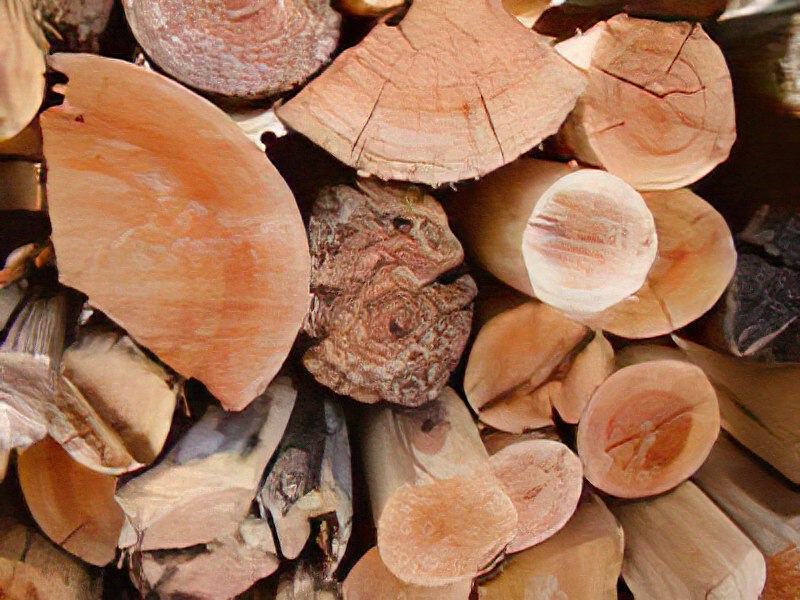What is a cord of firewood? If you’re like me, the first time you try to buy firewood, you are confused about all the terminology. In the US most large lots of firewood are described as a cord or some part of a cord, such as a half cord or quarter cord. What are these measurements and how do we compare them to smaller amounts? For example, at my local grocery store, they have firewood sales which are small bundles of wood that are 0.9 cubic feet of almond wood each. It would be nice to be able to compare this 0.9 cubic feet to a cord to see if I am paying a fair price.Below are some terms and conversions explained for a firewood cord and other frequently used measurements in firewood sales. Generally, firewood measurements are based on a volume of wood, as in the cord or stere:
What is a Cord of Firewood?
A cord is a measure of firewood that is used pretty much throughout the United States. A cord equals 128 cubic feet (ft3) which is the same as a woodpile of 4 foot-long logs stacked 8 feet wide and 4 feet high (8′ x 4′ x 4′). This is the most commonly used measurement for firewood sales in the US although be careful to not confuse it with a “face cord” as described below. Many firewood sales are based on smaller units than the cord. For example, it is common to sell half cords or quarter cords. A half cord is simply 1/2 the volume of a full cord while a quarter cord is 1/4 the volume of a firewood cord. Therefore 2 half cords equal one cord and 4 quarter cords equal one cord.
Face cord
In some areas, you may see wood labeled as a face cord, rather than a firewood cord. This is not legally defined and varies from one area to another. The size of these “face cords” can vary tremendously! So be careful when buying wood and make sure you are getting prices for a true firewood cord and not a smaller face cord.
Firewood bundle
It is common to see smaller boxes or bundles of woods at local supermarkets or home supply warehouses. These are not regulated and you have to look at each shipper’s packaging to determine the amount of wood contained within. In my area, it is most common to see 0.9 cubic foot bundles, but I’ve also seen up to 1.5 cubic foot bundles. To determine the price per cord, you’ll need to use the conversion from cubic feet to firewood cord.
Metric system (stere)
In the metric system (not often used in the US but commonly in Europe, Canada, and other countries), firewood sales are not based on a firewood cord and are rather based on the store. The store is one cubic meter (1 m3) which is roughly ~0.276 cords.
Australia (tonne)
In Australia, firewood is not sold as a firewood cord, it is sold by the tonne. A tonne is a measurement of weight, not volume as the stere and firewood cord are, so it is not exactly easy to convert. The conversion from cord to tonne will depend on the density of wood as some woods are heavier than others per unit of volume.
Conversions
1 cord = 128 cubic feet (ft3)
8′ x 4′ x 4′ stack of wood = 1 cord
half cord = 1/2 cord = 64 cubic feet
quarter cord = 1/4 cord = 32 cubic feet
1 stere = 1 cubic meter (m3) = ~0.276 cords
Example of conversion
Let’s say you have a local firewood vender who is asking $400 per firewood cord. Yet right next door to you you have a grocery store with firewood sales of bundles of 0.9 cubic feet for $5 each. If you divide $5 by 0.9 cubic feet, you get the price per cubic foot ($5.56). Now multiply this by the amount of cubic feet in a cord (128) and you get $711.11. This means that the price at the grocery store, per firewood cord, is much more than buying the full cord! It is a much better deal to buy the whole cord from the firewood sales vendor, assuming you have room for a whole cord at home! On the other hand, if you find that the smaller bundles offer no significant cost advantage over buying in large quantities, it may not be worth the trouble of buying, hauling, and storing a whole cord.
Be sure to check with your local vendors for prices for firewood cords, half cords, quarter cords and smaller bundles so you can figure out which is the best deal for you!
Hi, I’m Adam and I’m a HUGE fan of Food and Cooking.
Do you enjoy grilling sessions with your family while staring at the beautiful fire pit flames?
Flame Gorilla is the site to learn how to have that perfect backyard experience.

